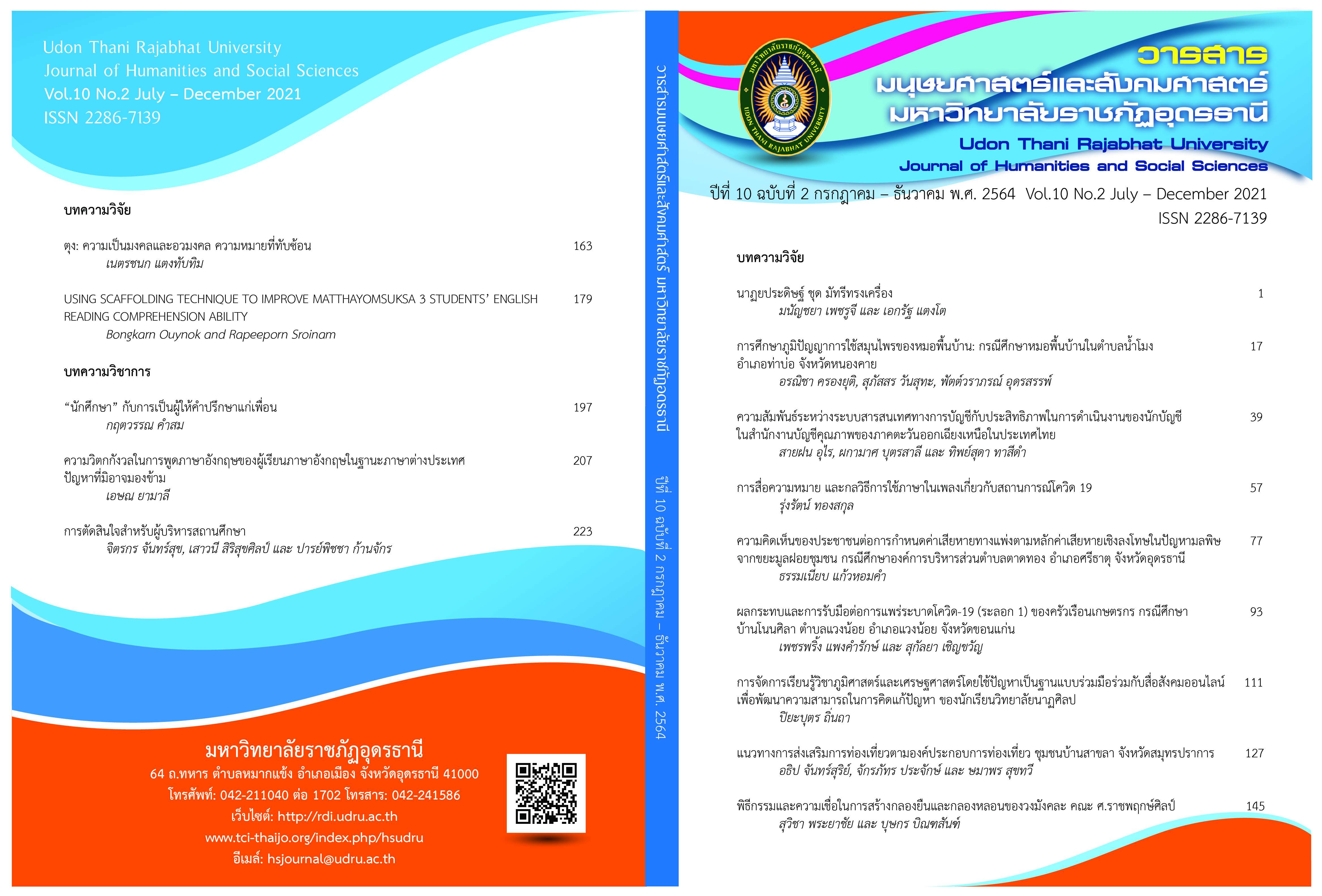ความวิตกกังวลในการพูดภาษาอังกฤษของผู้เรียนภาษาอังกฤษในฐานะภาษาต่างประเทศ ปัญหาที่มิอาจมองข้าม
Main Article Content
บทคัดย่อ
ทักษะการพูดเป็นทักษะหนึ่งที่มีความสำคัญอย่างมากในการพัฒนาภาษาอังกฤษ แต่หนึ่งในหลายสาเหตุที่ทำให้ภาษาอังกฤษของผู้เรียนโดยเฉพาะอย่างยิ่งผู้เรียนภาษาอังกฤษในฐานะภาษาต่างประเทศไม่เกิดการพัฒนาเท่าที่ควร นั่นก็คือความวิตกกังวลในการพูดภาษาอังกฤษ แม้ว่าผู้สอนจำนวนมากได้พยายามในการฝึกฝนหรือโน้มน้าวให้ผู้เรียนได้มีการพูดภาษาอังกฤษมากขึ้น แต่ก็ยังไม่สามารถลดความวิตกกังวลในการพูดภาษาอังกฤษเท่าที่ควร ปัจจัยหลักที่ทำให้เกิดความวิตกกังวลในการพูดภาษาอังกฤษประกอบด้วย ความหวดหวั่นในการสื่อสาร ความกลัวที่ได้รับการประเมินในด้านลบ และความวิตกกังวลในการสอบ สิ่งที่ครูผู้สอนสามารถช่วยให้ลดความวิตกกังวลในการพูดภาษาอังกฤษของผู้เรียนประกอบด้วย การสร้างการเรียนรู้แบบร่วมมือร่วมใจ การตระหนักในบทบาทหน้าที่ของครูผู้สอน และการใช้บทบาทสมมติ
Article Details
รูปแบบการอ้างอิง
ยามาลี เ. (2021). ความวิตกกังวลในการพูดภาษาอังกฤษของผู้เรียนภาษาอังกฤษในฐานะภาษาต่างประเทศ ปัญหาที่มิอาจมองข้าม. วารสารมนุษยศาสตร์และสังคมศาสตร์ มหาวิทยาลัยราชภัฏอุดรธานี, 10(2), 207–221. สืบค้น จาก https://so06.tci-thaijo.org/index.php/hsudru/article/view/247683
ประเภทบทความ
บทความวิชาการและบทความปริทัศน์
เอกสารอ้างอิง
ทิศนา แขมมณี (2550). รูปแบบการเรียนการสอนทางเลือกที่หลากหลาย. กรุงเทพฯ:
จุฬาลงกรณ์มหาวิทยาลัย
อารีย์ มีแจ้ง และคณะ (2559). การวิจัยเพื่อการประเมินการดำเนินงานของศูนย์พัฒนาการ
เรียนการสอนภาษาอังกฤษในประเทศไทย. วารสารศึกษาศาสตร์ มหาวิทยาลัยนเรศวร, 12(2), 17-31.
Al Hasni, S. (2014). Speaking difficulties encountered by young EFL Learners.
International Journal on Studies in English Language Literature (IJSELL), 2(6), 22-30.
Ansari, M.S. (2015). Speaking Anxiety in ESL/EFL Classrooms: A holistic
approach and practical study. International Journal of Educational Investigations, 2(4), 38-46.
Azhar, R. (2017). The correlation between students speaking anxiety and their
speaking ability. Malang.
Chen, T.Y., & Chang, G.B. (2004). The relationship between foreign language
anxiety and learning difficulties. Foreign Language Annals, 37(2), 278-289.
Dorneyei, Z. (2003). Attitudes, orientations, an motivations in language
learning: advances in theory, research, applications. Language Learning, 53(1), 3-32.
Gregerson, T.S. (2003). To Err is Human: A Reminder to teachers of Language-
Anxious Students. Foreign Language Annals, 36(1), 25-32.
Hadi, K,L. (2015). Using The Role-Play Technique to Improve the Speaking
Skills of Grade XI Students of SMAN 1 PANGANG in the Academic Year 2014/2015, Master Degree Thesis, English Education Department, Faculty of Language and Arts, Yogyakarta State University.
Horwitz, E.K., Horwitz, M.B. & Cope, J. (1986). Foreign language classroom
anxiety. The Modern Language Journal, 70(2), 112-126.
Indrianty, S. (2016). Students’ anxiety in speaking English (a case study in one
hotel an tourism college in Bandung). ELTIN Journal, 28-40.
Kratochwill, T.R., & Morris, R.J. (1985). Conceptual and Methodological issues
in the behavioral assessment and treatment of children’s fears and phobias. School Psychology Review,14(1), 94-107.
Kusnierek, A. (2015). Developing Students’ Speaking Skills through Role-
Playing. World Scientific News,7, 73-111.
Ladousse, G.P. (1987). Resources Books for Teachers: ROLE PLAY. New York,
Oxford University Press.
Lee, E.J. (2013). Corrective Feedback preferences and learner repair among
advanced ESL Students. System, 4(1), 217-230.
Mirhassani, A., & Ghaemi, F. (2007). Language teaching theories, methods, and
skills. Tehran. Kasa Kavosh.
Pattanapichet, F., & Changpueng, P. (2014). Cooperative learning: an approach
to reduce students’ anxiety in learning English. Exclusive Journal, 61-66.
Philips, E.M. (1991). Anxiety an oral competence: Classroom dilemma. The
French Review, 65(1), 1-14.
Sarkis, R. (2012). Using Cognitive Strategies to Improve English Skill an Self-
confidence. American Journal of Education Sciences, 2(4), 19-23.
Speilberger, C.D. (1980). Preliminary professional manual for the Test Anxiety
Inventory. Palo Alto: Consulting Psychologists Press.
Tribolet, S. (2012). Using Cognitive Strategies to Improve English Speaking Skill
a Self-Confidence. American Journal of Education Sciences, 2(3), 36-40.
Yoshida, R. (2008). Teachers’ Choice and Learners’ Preference of Corrective
Feedback Types, Language Awareness, 17(1), 78-93.
จุฬาลงกรณ์มหาวิทยาลัย
อารีย์ มีแจ้ง และคณะ (2559). การวิจัยเพื่อการประเมินการดำเนินงานของศูนย์พัฒนาการ
เรียนการสอนภาษาอังกฤษในประเทศไทย. วารสารศึกษาศาสตร์ มหาวิทยาลัยนเรศวร, 12(2), 17-31.
Al Hasni, S. (2014). Speaking difficulties encountered by young EFL Learners.
International Journal on Studies in English Language Literature (IJSELL), 2(6), 22-30.
Ansari, M.S. (2015). Speaking Anxiety in ESL/EFL Classrooms: A holistic
approach and practical study. International Journal of Educational Investigations, 2(4), 38-46.
Azhar, R. (2017). The correlation between students speaking anxiety and their
speaking ability. Malang.
Chen, T.Y., & Chang, G.B. (2004). The relationship between foreign language
anxiety and learning difficulties. Foreign Language Annals, 37(2), 278-289.
Dorneyei, Z. (2003). Attitudes, orientations, an motivations in language
learning: advances in theory, research, applications. Language Learning, 53(1), 3-32.
Gregerson, T.S. (2003). To Err is Human: A Reminder to teachers of Language-
Anxious Students. Foreign Language Annals, 36(1), 25-32.
Hadi, K,L. (2015). Using The Role-Play Technique to Improve the Speaking
Skills of Grade XI Students of SMAN 1 PANGANG in the Academic Year 2014/2015, Master Degree Thesis, English Education Department, Faculty of Language and Arts, Yogyakarta State University.
Horwitz, E.K., Horwitz, M.B. & Cope, J. (1986). Foreign language classroom
anxiety. The Modern Language Journal, 70(2), 112-126.
Indrianty, S. (2016). Students’ anxiety in speaking English (a case study in one
hotel an tourism college in Bandung). ELTIN Journal, 28-40.
Kratochwill, T.R., & Morris, R.J. (1985). Conceptual and Methodological issues
in the behavioral assessment and treatment of children’s fears and phobias. School Psychology Review,14(1), 94-107.
Kusnierek, A. (2015). Developing Students’ Speaking Skills through Role-
Playing. World Scientific News,7, 73-111.
Ladousse, G.P. (1987). Resources Books for Teachers: ROLE PLAY. New York,
Oxford University Press.
Lee, E.J. (2013). Corrective Feedback preferences and learner repair among
advanced ESL Students. System, 4(1), 217-230.
Mirhassani, A., & Ghaemi, F. (2007). Language teaching theories, methods, and
skills. Tehran. Kasa Kavosh.
Pattanapichet, F., & Changpueng, P. (2014). Cooperative learning: an approach
to reduce students’ anxiety in learning English. Exclusive Journal, 61-66.
Philips, E.M. (1991). Anxiety an oral competence: Classroom dilemma. The
French Review, 65(1), 1-14.
Sarkis, R. (2012). Using Cognitive Strategies to Improve English Skill an Self-
confidence. American Journal of Education Sciences, 2(4), 19-23.
Speilberger, C.D. (1980). Preliminary professional manual for the Test Anxiety
Inventory. Palo Alto: Consulting Psychologists Press.
Tribolet, S. (2012). Using Cognitive Strategies to Improve English Speaking Skill
a Self-Confidence. American Journal of Education Sciences, 2(3), 36-40.
Yoshida, R. (2008). Teachers’ Choice and Learners’ Preference of Corrective
Feedback Types, Language Awareness, 17(1), 78-93.


